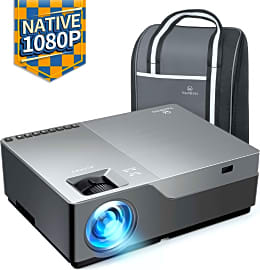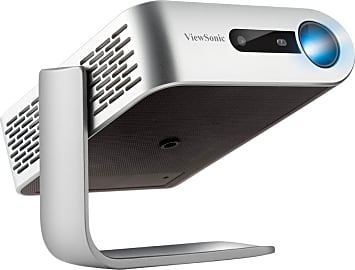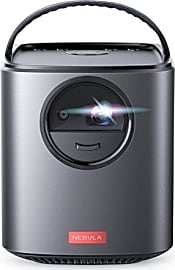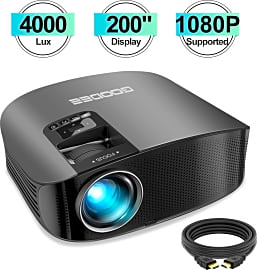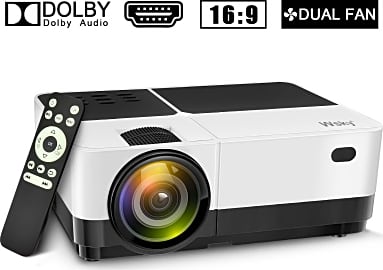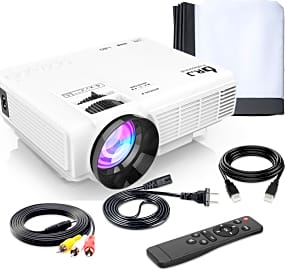The 8 Best Outdoor Projectors

This wiki has been updated 41 times since it was first published in December of 2016. Enjoy your favorite movies in the fresh air and under twinkling stars with one of these outdoor projectors. The models we've selected produce enough brightness and contrast to overcome most light pollution, and some even run on battery power, so you can take them anywhere. We've ranked them here by their light output, portability, software and hardware features, and maximum resolution. When users buy our independently chosen editorial picks, we may earn commissions to help fund the Wiki.
Editor's Notes
November 10, 2020:
Since our last update, the TaoTronics Video Home Theater and the iCodis G6 Multimedia have become unavailable. As a result, we’ve added the Dr. J Professional HI-04 and the Vankyo Burger 101 in their place. Both of these models support connections to a wide variety of devices including laptops, TV sticks, USB drives, and smartphones. The pocket-sized Vankyo Burger 101 really sets itself apart from the rest, since it also supports wireless streaming and doesn't need to be plugged into a power source at all times. Thus, it's a particularly convenient entertainment system to bring along on camping trips and other outdoor gatherings.
We've also noted that the Wsky Portable no longer comes in three colors. However, this model has continued to provide users with extremely clear pictures and high sound quality, so we still believe it's a good budget-friendly choice for outdoor movie screenings.
June 11, 2019:
Turnover in this category is pretty high, and only the iCodis G6 remained on our list, as it's one of the few models from our previous ranking that hasn't been upgraded in some way. Epson, who had a number of high-end offerings last time around is completely absent here, as they haven't come out with a viable outdoor option in a couple of years. They do have a few newer models designed for sheltered home theaters, but while these certainly have the specs in brightness, contrast, and resolution to compete outdoors, there's not much sense in taking an extremely expensive projector into the elements. There's a point at which this category is successful because the loss won't be so significant if you get caught in a sudden downpour or some kids running around the campsite knock your setup into the mud. All that said, there are a couple of nice options that made their way toward the top of our list from familiar brands, most notably LG's entry at number one. Its long battery life and full 1080p resolution were an undeniable combination.
The Magic Of The Outdoor Movie Night
One evening, after a long day of demolition, the two of us drove into the town on the outskirts of which we’d spent our day.
About a decade ago, I was working all around Virginia with a buddy of mine, painting houses, performing light demolition work, and doing my best impersonation of an itinerant beatnik. One evening, after a long day of demolition, the two of us drove into the town on the outskirts of which we’d spent our day. It was a quaint place, a throwback to the Main St. days of post-WWII America — and yes, that means it was shamefully homogenous. It was an easy-going atmosphere, though, with an old mill slowly turning by a waterfall and a long, expansive park occupying the town center.
As we drove past the park around sunset, the orange sky turning the trees a deeper green than I’d ever seen, we noticed a crowd of people standing at roughly the center of the grass. We decided to park and go investigate. When we got to the crowd, we saw that people were taking their seats in front of an outdoor projection system, complete with a projector, a small speaker system, and an inflatable screen.
The mood in the crowd was almost saccharine, but there was nothing abrasive about it despite my young poet heart’s yearning for constant adventure. Perhaps it’s because the days of the drive-in were long gone before I was even born. Perhaps it was a sense of community I hadn’t felt much of during my long journey through the south. Perhaps it was just spending a nice night outdoors after being cooped up in a crumbling house all day. Whatever it was, that screening was magical.
These are the kinds of experiences you can foster with an outdoor projector: mysterious nights of light and shadow, the thick, flowery air of a summer evening mingling with the sights and sounds of the cinema.
What Qualifies A Projector For Use Outdoors?
One look at the projectors on our list will confirm that there isn’t some exceptionally rugged design that makes outdoor projectors more durable in the elements than their indoor counterparts. In fact, outdoor projectors are usually just more powerful than indoor projectors. The reason that the extra power is necessary requires a little understanding of the projection process.
A projector screen is designed to reflect light back at an audience in as much detail as possible. There are a lot of things that can interfere with that relay, however, and the most common culprit is ambient light.
Before the previews started, you might have noticed the house lights in the theater getting a little dimmer.
Picture yourself in a movie theater. The show’s about to start after what seemed like an hour of previews. Before the previews started, you might have noticed the house lights in the theater getting a little dimmer. By the time the main event begins, those light are completely out. That’s because particles of light can collide, and any light that gets in between the reflection coming off the screen and your eyes will dilute the clarity of the picture.
To battle against this, movie houses screen their films in darkness. Outdoors, however, you can’t simply turn off all the streetlights, close off all the roads, and reverse the constant hum of light pollution. With a projector that only has the specs to work indoors, in a controlled environment, your movies will look pale and milky on an outdoor screen, lacking detail and sharpness.
In order for a projector to be useful outdoors, it has to have the ability to create a brighter image with more contrast than what comes out of more conventional projectors. These two features of an image can do a better job cutting through ambient light, and will help ensure that your movie is as enjoyable as possible.
Some outdoor projector are also capable of running on batteries alone. These are ideal for outdoor movie nights where there isn’t access to AC power. It’s rare to see any kind of weather sealing added to a projector, even if it’s marketed as an outdoor unit. Traditionally, rain, fog, wind, snow, and other inclement weather events don’t make for the most comfortable movie nights, so manufacturers don’t expect you to run their devices in such conditions.
How To Choose The Right Outdoor Projector
As we mentioned above, brightness and contrast are among the most important features to consider when evaluating a projector for outdoor use. Manufacturers relay these two variables to consumers by a pair of numbers called lumen output and contrast ratio.
Generally speaking, the higher the number on the left, the more dynamic a picture you’re going to see, even with interference from ambient light sources.
A lumen is a unit of brightness derived from an old standard measurement known as a candle. The higher the lumens number, the brighter you can make your image. Contrast ratio is displayed as a ratio, such as 1000:1. In this ratio, one (the number on the right of the colon) is always used to represent the darkest black level of the image in which there is still visible detail. The number on the left side of the ratio corresponds to the level of brightness at which an image still contains detail. This equates to what is often called the dynamic range of an image. Generally speaking, the higher the number on the left, the more dynamic a picture you’re going to see, even with interference from ambient light sources.
If you narrow down your choices to two or three projectors that have very similar lumens ratings and contrast ratios, it might provide you some peace to know that these numbers aren’t terribly exact. It’s smart to think of them like television measurements, which are divided into classes. You might get a 46-inch class TV that’s actually 45.6 inches as easily as you can get a 46-inch-class TV that’s actually 46.7 inches. Lumens and contrast ratio are figures designed to loosely classify brightness and dynamic range.
After that, you can look at these projectors like any other. What’s the minimum distance between the unit and the screen? How large of an image can you project without losing detail? How adjustable is the keystone? In most cases, shorter throw distances, larger screen capabilities, and more keystone adjustments are all good things.


